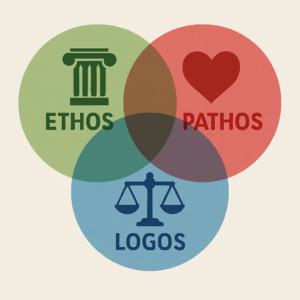Ethos, Pathos, Logos: Implementing the Rhetorical Appeals in Scientific Writing

As researchers, we want nothing more than the world to see and trust our work! We strive to convince the scientific community of the credibility of our findings through research publication. However, are we doing it right? How do we get our readers to see our viewpoint and arrive at the same conclusions that we did?
Enter rhetorical appeals! Introduced by the Greek philosopher Aristotle, the three rhetorical appeals “ethos,” “pathos,” and “logos” are designed to help readers accept your argument. In this article, we will learn what each of this appeal means and understand how they can be implemented in scientific writing.
What are Pathos, Logos, and Ethos?
Ethos Definition
Ethos appeals to the readers by convincing them to trust you. The focus is on the writer, meaning you, and your job is to persuade your audience that you deserve their trust. Here are a few ways to do that:
- Show them that you are knowledgeable! Present the paper with sufficient, verified content to keep the readers well-informed.
- Highlight your credibility! Do not shy away from mentioning your experience in the field. You can also cite well-researched sources in your paper to show that you are well-versed in your subject.
- Keep the research paper professional and error-free. A well-formatted manuscript helps create a great first impression, enabling trust between you and the reader.
Pathos Definition
Pathos targets the readers’ emotions to get them to care about your argument. This is often seen in movies, wherein the storyline appeals to viewers’ emotions to keep them hooked. But how do you incorporate this in writing?
- Tell a story! Your research paper can do more than just present facts and figures. Develop the art of storytelling to engage your readers from the Introduction to the Conclusion of your paper.
- Pathos can appeal to both positive and negative emotions. However, you need to do more than just tug at heartstrings in academic writing! Use adjectives and verbs to describe your analysis and to present a vivid imagery of your study.
Logos Definition
Academics find logos to be the easiest of the three appeals! The objective is to use logic and ask the readers to believe in your argument because it makes sense. Here’s how you would go about it.
- Provide factual evidence for your argument. Well-established and verified information from previous works can help build your case easily.
- Include graphical data, illustrations, figures, and tabular data—anything that proves your argument in a visually appealing manner adds weight to your study.
- Reason with the readers logically. Do not make extremely far-fetched claims or present unverified information to mislead them. This can damage your reputation and credibility, and you will lose the trust that was gained through ethos!
Ethos, Pathos, and Logos Example
With these definitions in mind, here’s an example that integrates ethos, pathos, and logos. See if you can identify them correctly.
The elephant calf stood close to his mother, too shy (or perhaps too scared) to move away from her. He had taken his time to stand up—most elephant calves can stand on their own feet within 20 minutes of birth! In another hour, he will be able to walk and even keep up with the herd in a couple of days. I intend to document the journey of this little calf throughout the monsoon season for my upcoming documentary on African elephants. [Ethos example]
Of the three species—African Savanna (also referred to as the Bush elephant), African Forest, and Asian—the African Savanna elephant is the largest land animal. I have been a wildlife photographer for over 15 years, and these giant yet gentle creatures continue to leave me in awe! Be it their communication skills, their multi-purpose trunks, or their beautiful ivory tusks, elephants are fascinating animals. However, not everyone views them the same. [Pathos example]
Nearly 90% of African elephants have been destroyed in the past century, mainly because their tusks make great business for ivory trade. Although the population of Asian elephants has not dwindled as much as their African counterparts, their habitat is changing due to human settlements and agricultural lands. This in turn is affecting their conventional migration routes of reaching water or their feeding and breeding grounds, causing them to come into dangerously close contact with people. [Logos example]
As a wildlife photographer and nature conservationist, I hope my documentary helps educate my audience about the lives of these mammals and why they need to be protected.
How to Use Rhetorical Appeals in Scientific Writing
In the above fictional example, the writer of the blogpost first uses pathos to appeal to the emotions of the readers and then uses ethos to establish credibility. The post then uses logos to indicate that Asian elephants will also be affected like African elephants if they are not protected.
While this sounds quite easy in an informal setting, how do you integrate the rhetorical analysis in scientific writing? Ideally, you should try to combine the three rhetorical appeals.
Here’s a summary of how the rhetorical analysis can be used in different sections of a research paper.
- The Introduction section of the paper can use a combination of ethos and pathos to present the motivation for your study and to highlight the research objectives.
- In your Literature Review section, use ethos to showcase your credibility. Cite relevant works and explain your understanding of these previously reported findings and how you have built your study on them.
- The Methodology and Results sections mainly use logos. Provide logical reasoning for choosing a specific experimental technique or analysis method. Use figures, graphs, and tabular data to support your analysis and to validate your findings in the Results section.
Note: Depending on the study, you might have to incorporate pathos in the Methods section if your study involves human or animal subjects.
- Finally, in the Discussion and Conclusion sections, use a mix of logos and pathos. Provide logical reasoning for your interpretation of the results and call for action by highlighting the potential future lines of investigation.






